My team admittedly has a distinct advantage when it comes to link building and making connections. Our company has worked with bloggers in our niches (cooking and crafting) for years, making it easy for us to reach out often for a shout out or small promotion from our trusted blogger network. Surprisingly enough, however, this does not always lead to quality links.
In the past year, we have decided to dedicate a team to audience development. This team focuses on creating longform content, building reader relationships, and (of course) link building. Over the past year, our 35 websites have earned 707 links total from bloggers. 405 of those links were to our top websites. These are the links I examined for this article.
Links We Earned This Year
From January 1, 2017 until April 26, 2018, our editorial team has earned over 700 links to our websites and content that our bloggers told us about. My company manages 35 websites, meaning each site received around 10 to 20 links. For the purposes of this blog post I examined the incoming links to the 6 top sites. I looked at the first 300 of these links to see what our network was linking to and found the following:
- Branded links, or links directly to the homepage, made up a bulk of these links at 29.14%
- This was closely followed by project and recipe roundups or lists (23.71%). Working with a strong blogger base means this time-honored linking tradition is still going strong for us.
- The other big chunk of these links were to the blogger’s own content on our site or their profiles (18.36%).
While a wide variety of content earned us links this year, we discovered three strategies that consistently brought in high-quality, long-standing links.
1. Appreciation and Best Of Posts – Earning Links from Your Network
Nearly 9% of all of the links we earned in 2017 and 2018 thus were to a handful of “best blogger” pages to our sites. These lists are not simply round ups of bloggers we like in the industry, but instead are round ups of bloggers we work with on a regular basis. These collections prominently feature our favorite video channels, collaborators, and more. Instead of reaching out for the first time, these pages leveraged our existing relationships. They promoted our friends and told their stories.
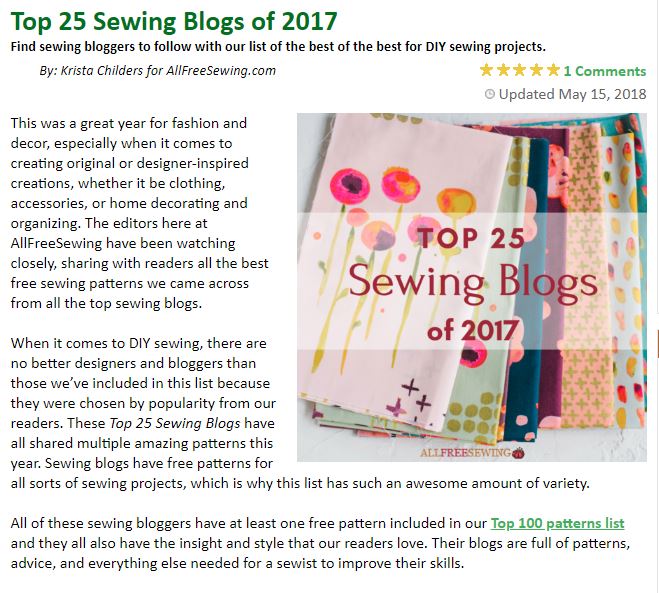
Examples
https://www.allfreesewing.com/Basics-and-Tutorials/Top-25-Sewing-Blogs
https://www.allfreecrochet.com/Miscellaneous-Crochet/Top-25-Crochet-Blogs
Why it Worked
This content worked because it utilized pre-existing relationships with our contributors instead of just wishing for a link-for-a-link relationship with a stranger or new connection. We work closely with our blogger network and these posts were initially designed as a thank you and a shot out. Since this content was about them instead of simply mentioning them flippantly, people were excited to announce that they made they list. Creating content about your users, contributors, and connections shows you appreciate them and that genuine content and connection encourages linking. You’re telling their story. Not just baiting them with a PR mention.
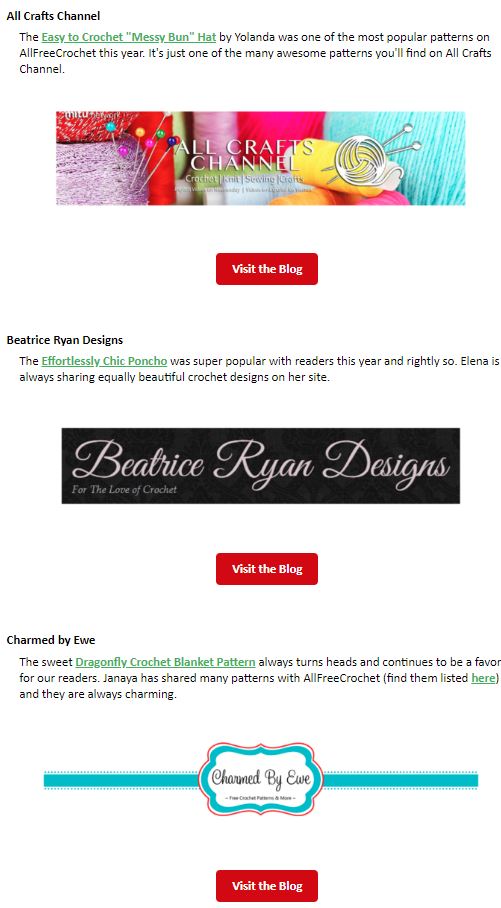
How it Could Work for Other Brands
While we run a pretty specific type of website with a heavy amount of user-generated content, this process and general concept could easily be applied to plenty of other brands. Consider creating content about your users and customers. SaaS companies, for example, could utilize case studies to highlight the work their favorite customers are doing. Blog posts like 5 Ways Our Customers Are Transforming Their Industry with XYZ gives them a genuine, interesting brand mention that will likely lead to links and shares. Retailers could easily create content around particular branches and stores, earning local links and media mentions. What do you really love about your customers? What story do they have to tell? These stories are engaging, interesting, and linkable!
2. Hyper Specific How To and Q&A Articles- High Quality Linking Practices
While this type of content did not earn us a high volume of links (about 3%), it did earn us the highest quality of link. Rather than linking to our homepage or a simple brand mention, our reference and how to content outperformed all other links when it came to the link itself. These pages are consistently linked to with their title or exact keyword matching for our intended keyword cluster. If you’re hoping to boost your authority in your niche or a particular topic, this is the way to go.
Our top content for this particular content type was NOT a general or all encompassing topic like how to cook steak or how to crochet. Instead, the content that did the best here was for hyper specific skills and techniques or specific questions that are not often answered in those other general, higher level content. It helped solve one particular problem.
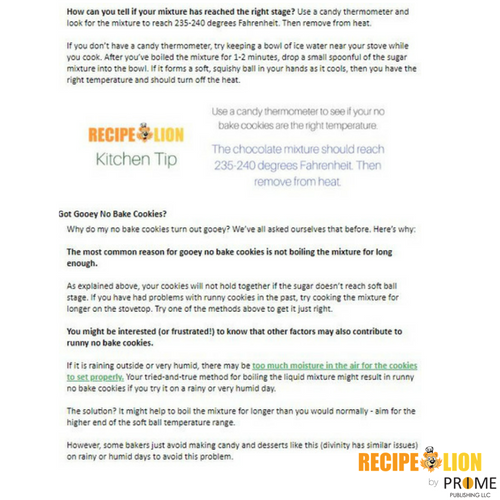
Examples
https://www.allfreeknitting.com/Knitting-Tutorials/Condo-Knitting
https://www.recipelion.com/Cookies-and-Bars/No-Bake-Cookies-Too-Dry-Gooey
https://www.recipelion.com/Casserole-Recipes/Thaw-Frozen-Hash-Browns
Why it Worked
This content works on several levels. First and foremost, it is addressing an obscure question that by and large has yet to be covered on its own. While many articles on no bake cookies, for example, may mention issues with consistency and texture, a thorough explanation of them is a unique and engaging piece of content. These always do well on social. It answers a question that might have have been answered already.
Secondly, this content is much easier to link to than the dreaded listicle. This article provides a unique value that makes it very linkable. When reaching out, we are able to mention that we have a thorough explanation for a technique or recipe that might be worth mentioning.
We have also had success with the gentle nudge that the blogger failed to mention something in their recipe and providing the research for them. “I noticed you didn’t mention whether or not to thaw the frozen potatoes for your casserole. Is this something you would recommend? We actually just wrote an article about this since some of our readers were asking.” This allows you to create content that is adding to their own and participate in a conversation.
This type of content also does an awesome job of earning links naturally over time.
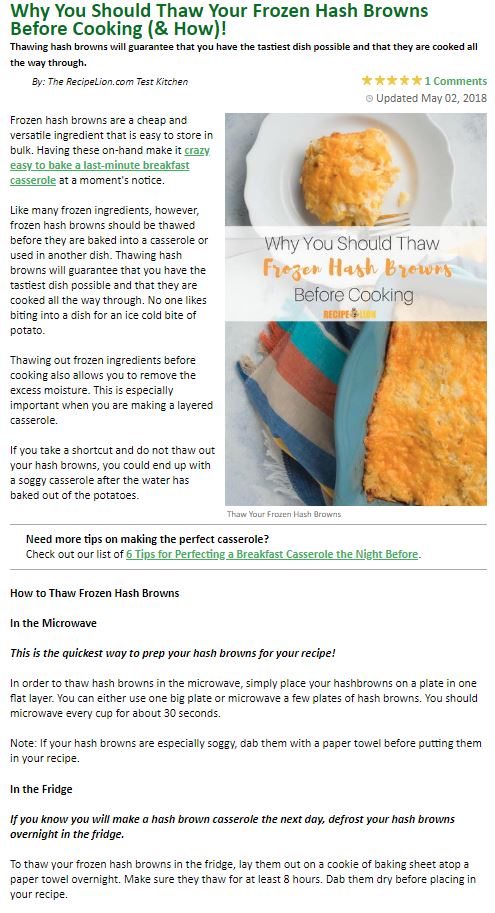
How it Could Work for Other Brands
What is often called pillar or reference content is not a brand new concept for any content marketer. We have all worked on creating this higher level, long-form content at one point or another. What is important to note about this strategy is the specificity. It solves a short-term and very specific problem a user might have, something that might be mentioned in these longer form pieces of content (and linked to)! Finding these topics can be tricky, but there are resources out there. Try perusing the “people also ask” sections of the search engine result page or the tool AnswerthePublic.com.
The trick here is to find a great topic that aligns with your goals. Our readers for our knitting site, for example, are generally retired women with limited income. Condo knitting is a vintage style of knitting that was popular in the 70s, so it offered a nice #throwbackthursday vibe. Our readers don’t tend to love higher end materials, so writing an article about how to care for expensive alpaca or cashmere yarn would not have done as well for our intended audience.
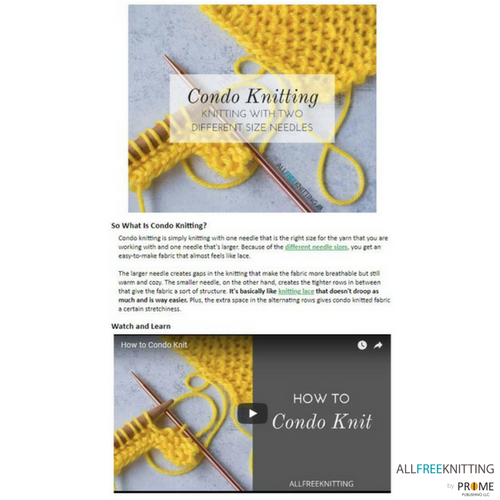
SaaS companies could do this by writing a shorter, snackable article about a specific solution their platform offers (like Buzzstream locating email addresses). Retailers can easily create articles on how to care for their product. Remember to find a specific topic. We’re not looking for “how to care for a mattress” and instead looking for something like “how soon after buying a new mattress should you flip it” or “can sleeping on a short mattress cause back problems”. As an added bonus these low stake, content snacks tend to do fairly well organically when you find the right topic. This article about thawing frozen hash browns we created last week is already receiving about 10 or more organic clicks a day and it took the team about an hour to put together. Staffing wise, it will likely pay for itself pretty quickly in leads and ad dollars.
3. Collaborative Content and Promotions – Working with your linkers!
Two of our biggest projects every year are National Craft Month and National Sewing Month. These month-long promotions and content calendars provide 30 days of new content to our readers as well as a myriad of giveaways, freebies, and more. Our entire editorial team gets on board to create the content, finding bloggers to help with projects, and promote the content. These large scale projects are link-earning machines. This year alone National Sewing Month earned us about 25 links while National Craft Month (on our biggest site) far exceeded that by earning around 3-5 links per project, earning us just under 90 links in total! These promotions consist of brand new high quality content created by our editorial staff as well as collaborators. With such a big group working together, the link building is natural and expected.
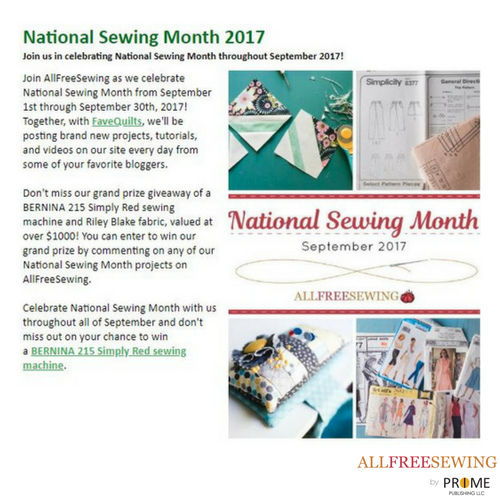
Examples
https://www.allfreesewing.com/Miscellaneous-Projects/National-Sewing-Month-2017
https://www.favecrafts.com/Most-Popular-Crafts/National-Craft-Month-2018
Why it Worked
Rather than focusing solely on bringing links inward, these month-long promotions focus on creating content with creators we love. They share projects on our sites in full as well as promote them on their blogs. Readers have the option to win a ton of prizes. We send out social media blasts, tag everyone, and create a community around one promotion. Rather than just linking to us, collaborators on these projects feel as if they are part of something. They submit project ideas and applications to be apart of the promotion, giving it just a little exclusivity. It is something they are proud to be apart of and want to share. This means promoting their projects on our domain is also promoting their very own brand.
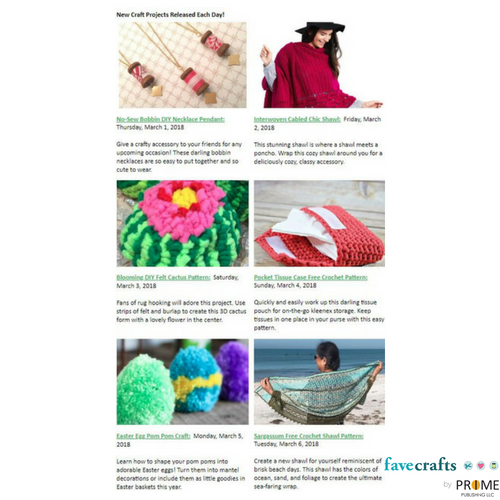
How it Could Work for Other Brands
While brands might not have as strong as a collaborator or blogger network to pull from, the overall idea of creating a community and an event instead of single pieces of content is easily transferable. Depending on your goals and resources, it would be just as easy for companies to create week-long promotions showcasing new content from talented collaborators and freelancers. Digital promotions like this one give collaborators a feeling of community. If they are part of something, they’re likely to promote and link to their own content as well as those within their network. SaaS companies could easily create a week of webinars and retailers or brands could easily borrow from influencer campaigns to create a week of DIY ideas or recipes using their products.
Creating week-long or month-long content calendars also has the added bonus of inspiring internal promotion. If your company does something new and exciting, your staff is more likely to share the engaging content on their personal channels and blogs. Organic social promotion is just as useful for brand promotions as link building even if it is a little more ephemeral.
Build Relationships and Links Will Follow
My team creates a wide variety of content with several goals in mind. We’ve created a lot of longform and reference articles for our site to add value for our readers and promote our Youtube content and videos. We’ve created shorter listicles for users who are just looking to browse. We’ve even created content focused solely on building links that involved a lot of ego-baiting within listicles. Many bloggers are willing to link back and share the love, but I have a sneaking suspicion that this is because of our existing relationships and not the content itself.
After a year of link building and hundreds of reach outs, our main takeaway is that curating excellent content and working closely with the collaborators we love is the best way to earn links. Working with other content creators to create content either through shared promotions or offering them something extra (like a niche reference article) is going to earn you more links than a 1,000 cold emails ever will.

 End-to-end outreach workflow
End-to-end outreach workflow



 Check out the BuzzStream Podcast
Check out the BuzzStream Podcast


1 comment
Really insightful – I’ve been exploring the use of Q&A with great success, but I’ll be trying your other methods out ASAP.